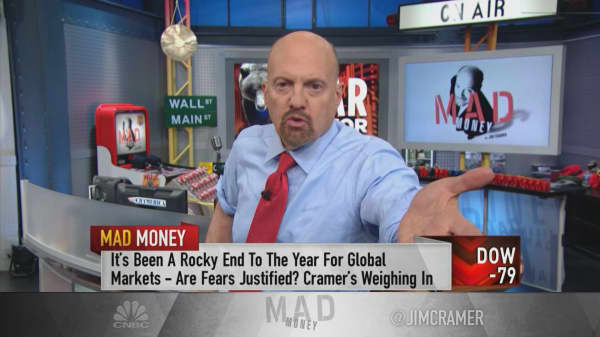The Fed is fighting 4 inflationary trends it can’t control, Cramer says
- CNBC’s Jim Cramer flags four trends complicating the Federal Reserve’s tasks of keeping inflation at bay while keeping Americans employed.
- Decreasing immigration, minimum wage boosts, a lack of truckers and the potential for higher tariffs are all making the Fed’s job more difficult.
- On Thursday, stocks mounted a recovery after the Wall Street Journal reported that Fed officials are seriously considering taking a wait-and-see approach to the central bank’s 2019 interest rate plans.
The Federal Reserve is navigating four trends that it can’t control, but that directly affect its policies, CNBC’s Jim Cramer said Thursday after the stock market recovered from a massive intraday decline.
Stocks mounted a recovery late Thursday after the Wall Street Journal reported that Fed officials are seriously considering taking a wait-and-see approach to the central bank’s 2019 interest rate plans after a widely expected rate hike in December.
But four disruptive trends — decreasing immigration, state-level minimum wage boosts, a nationwide lack of truckers and the ongoing trade dispute between the United States and China — are turning into an “awfully awkward situation” for the Fed, which is tasked with keeping inflation under control while keeping the economy humming, Cramer said.
“The Fed is fighting four trends that it doesn’t have any control over that are creating inflation,” the “Mad Money” host said.
First is President Donald Trump’s crackdown on immigration, which translates into fewer workers, especially those willing to take lower-wage jobs, and therefore higher wages. Second are state-level minimum wage boosts that amount to government-mandated wage inflation.
Third is the countrywide truck driver shortage, which has become “a major reason for all sorts of companies to raise prices … in order to make their customers eat higher shipping costs,” Cramer explained.
Fourth, but certainly not least, is the United States’ trade dispute with China, further escalated this week by the arrest of the CFO of Huawei, one of China’s most important companies. While Trump and China’s president seemed to agree to a ceasefire over the weekend, the arrest “makes the odds of a good trade deal most unlikely,” Cramer argued.
All four of these ongoing issues directly affect the Fed’s policy, and that’s what’s putting this independent entity in a bind when it comes to planning for the year ahead and maneuvering other major, economy-altering changes like the rise of workplace automation.
“Think about it: the Fed can’t change immigration laws. The Fed can’t lower the minimum wage. The Fed can’t train more truck drivers. The Fed can’t stop Trump from raising the tariffs,” Cramer said. “So what can it do? Well, they can make it too expensive, or too scary, for businesses to hire more people.”
Cramer, who has argued that the Fed should take a data-dependent, wait-and-see approach to its rate hike agenda, again called for more “common sense” and “prudent data dependence” at the central bank.
But, for now, investors might want to consider keeping their powder dry instead of trying to buy the market’s swings, the “Mad Money” host advised.
“If you took a long-term approach, buying stocks into weakness today based on their intrinsic worth rather than their minute-to-minute value, you actually came out on top as the averages roared back from their lows,” he said. “However, there are two caveats. We don’t know what the White House is planning on trade and we don’t know how the Fed will react to tomorrow’s employment number. For today’s lows to hold, at least one of these institutions needs to be rational and prudent. Who knows? Crazier things have happened.”
[“source=cnbc”]





